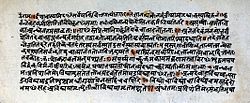Upanishad
| Hindu texts |
Śruti
|
The Upanishads are some of the sacred books of the Hindu people. The Upanishads are part of a large collection of sacred books of Hindu people, called the Vedas. They are placed at the end of the Vedas and they primarily deal with knowledge or wisdom. Because they deal with knowledge portion of the Vedas, they are called Jnana-Kanda (Jnana means knowledge). Also because they come at the end portion of the Vedas they are often called texts of Vedanta (veda: of vedas, anta: at the end). Upanishads form the foundation of the philosophy of Hindu religion. Many scholars believe that originally Upanishads are rebellion against Vedas and it has added to Vedas by its unique spiritual quest. Upanishad means "sit down with" master to learn about the Atman(soul). The Upanishads do not belong to a specific period of Sanskrit literature. The oldest, such as the Brhadaranyaka Upanishad and Chandogya Upanishad, may be as old as 8th century BC, while the youngest, depending on the specific Upanishad, may date to the medieval or early modern period. More than 300 text about Upanishad have been found but we have 108 Upanishad in written. Geeta which is the most religious book of Hindu's is also a Greatest Upanishad.
Upanishad Media
A page of Isha Upanishad manuscript
Impact of a drop of water, a common analogy for Brahman and the Ātman
Adi Shankara, expounder of Advaita Vedanta and commentator (bhashya) on the Upanishads
German 19th century philosopher Arthur Schopenhauer, impressed by the Upanishads, called the texts "the production of the highest human wisdom".
Other websites
- Philosophia Ultima:Osho commentary on Mandukyopanishad Archived 2011-01-03 at the Wayback Machine





